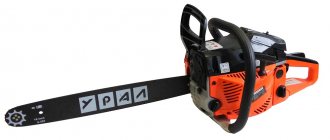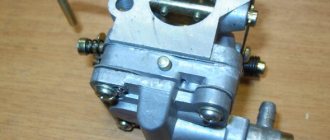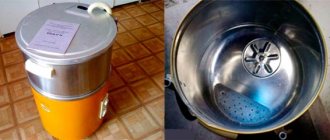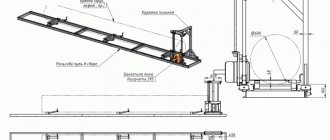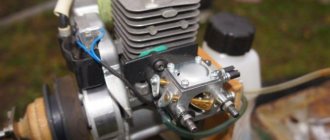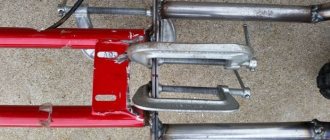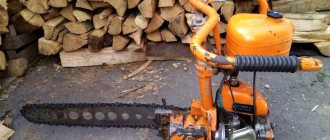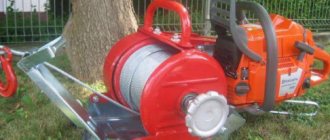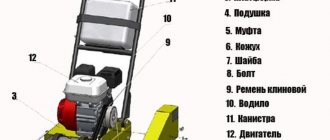What can be made from a chainsaw
Homemade chainsaws belong to a very wide class of devices. This is a hand-held tool with a motor drive, such as:
- Bulgarian;
- motor drill;
- cultivator;
- snow blower;
- stationary machines and devices: sawmill;
- electric generator;
- motor pump;
- snowmobile;
And these are probably not all the possible homemade chainsaws.
Boat motor based on a gasoline saw engine
Making a boat motor from a chainsaw is not difficult. The modification is performed as follows:
- remove the bar from the saw;
- instead, a self-made or factory-made boat propeller is attached to the motor using a special adapter;
- the entire structure is then secured to the boat so that the propeller plunges into the water at an angle.
Instead of an adapter, some craftsmen install a gearbox. The possible result of the work is demonstrated in the photo below.
For fishing enthusiasts, a homemade boat motor is an economical option that can significantly speed up movement across the water surface of lakes, rivers, and ponds.
Rework principle
The principle of alteration is very simple and combines the entire range of home-made devices and assemblies. A chainsaw is used as a drive. The unique qualities of the chainsaw motor, capable of operating at very large tilt angles, perhaps not upside down, allows this universal drive to be used in many designs. In the case of using a chainsaw as a drive for a homemade hand-held power tool, most of the parts of the original chainsaw are retained, and only the working part is changed.
Walk-behind tractor from a chainsaw
If, on the basis of a chainsaw, you make a stationary machine or vehicle with your own hands, the alteration becomes deeper. A gearbox, variator or belt drive is added to the design, the fuel tank is replaced with a more capacious one to ensure long-term operation without refueling.
Homemade sawmills from electric saws: design options
Among all the variety of homemade products made from electric saws, sawmills are the most popular and widespread product that craftsmen have been producing for many years.
Factory analogues of such devices are quite expensive due to their high performance. They are capable of processing thousands of cubic meters of timber per day of operation. When there is neither such a scale of woodworking nor finances, you can pay attention to one of 3 types of homemade sawmills:
- tape; They have a complex design, but are adapted to any working conditions.
- disk; Quite easy to assemble, but not reliable, which is why they are in demand among amateurs. Circular sawmills based on electric saws are quite common in everyday life, productive and versatile in the tasks they perform;
- chain
In view of this, we will dwell in detail on their manufacturing technology.
Transport
Based on a chainsaw engine, you can make many homemade vehicles. It is important to remember that transport is a means of increased danger and the author and owner of the homemade product bears full responsibility for its safety.
Snowmobile
Structurally, a snowmobile is one of the most complex homemade products. The following components will need to be made:
- Support frame.
- Frame.
- Caterpillar.
- Front ski.
- Steering wheel with controls - gas and clutch handles.
- Suspension.
- Transmission.
The supporting frame is welded from a square steel profile 20*20 or 20*30, it is necessary to provide a swing arm for the shock-absorbing rear suspension and install a motorcycle-type steering fork for the front. There are options with two skis - here the design of the front suspension will be more complicated - the steering wheel will not turn the axis of the ski, but pull the levers to control the steering linkage. This option is more difficult to manufacture, but guarantees better controllability and stability. For a snowmobile, a centrifugal clutch with a V-belt and chain is suitable. To increase the traction force, a gear is installed on the working shaft of the caterpillar, which is larger in diameter than the drive gear on the chainsaw shaft. For the caterpillar, you can take ready-made drawings from a light snowmobile with an engine of the same power as a chainsaw.
In order for a homemade product to confidently carry one or two people, the engine power must be at least five horsepower.
Snowmobile
A snowmobile is much simpler in design than a snowmobile; according to the principle of its operation, it resembles a small propeller-driven airplane moving on the ground. The load capacity, maneuverability and stability will be noticeably lower than that of a snowmobile with equal engine power. The advantage will be simplicity of design, greater reliability and greater speed in open spaces. The pusher type screw is installed in the protective casing of their mesh behind the driver's back and pushes the device forward. The device is controlled by turning the ski, the gas lever and the snow brake.
Homemade snowmobiles
In order to properly accelerate a homemade snowmobile or drive not only on the smooth ice of a frozen river, but through fields and small snowdrifts, you will need a chainsaw engine with a power of at least 10 horsepower.
Moped
A homemade summer vehicle with a chainsaw engine is unlikely to compete with industrial designs. Home craftsmen often assemble it as a test of their strength or as a training session before more serious designs. In addition to the chainsaw, you will need an old bicycle, or at least the main components from it, including bearings. Craftsmen weld the frame themselves from pipes or square profiles. It looks scary, but it is reliable. The drive is carried out to the rear axle by a bicycle chain.
The most advanced home craftsmen use a mountain bike with high-quality brakes and shock-absorbed suspension as a basis. A gearbox with a gear ratio of 1:15-1:20 and a variator are added to the chainsaw. With such a homemade product you can already travel quite comfortably at speeds of up to 30 km/h.
Homemade kart based on a chainsaw
What else can be made from a Ural or Druzhba saw? For example, a go-kart is a maximally simplified car model designed specifically for circuit racing. It is devoid of a body, shock absorbers, and sometimes even brakes - everything is done to make the design as light as possible to increase speed. The homemade kart frame is made from profiles or steel pipes. DIY wheels are often taken from industrial carts for transporting small loads. The drive is carried out to the rear axle by a bicycle chain, the steering linkage is taken from a minicar. To assemble the card you will need intermediate level metalworking and welding skills. It is better to take ready-made drawings as a basis and adhere to their basic parameters - although karting is considered a “children’s” sport, the speeds developed are quite adult, and you can seriously injure yourself.
Using a similar scheme, based on a chainsaw motor, craftsmen assemble the kart’s older brother, the buggy. This carriage has a reinforced suspension with large strokes and is designed for racing over rough terrain. The homemade center of gravity is located low to improve stability; the driver and passenger seats on top are protected by a powerful roll bar. The process of making a children's ATV will also be very similar.
Homemade scooter with a chainsaw motor
Despite the fact that this device looks like a children's toy, it can be a serious help to a postman or courier. Even though the scooter's maximum speed is low, 10-15 km/h, it has excellent maneuverability and incomparable efficiency. If the working day consists of many short trips from point to point, you couldn’t ask for a better option.
DIY scooter
Almost the entire structure of the chainsaw is preserved; you only need to remove the bar and the saw chain, replacing it with a bicycle chain that transmits torque to the rear wheel of the homemade scooter.
boat motor
Homemade boat motors first appeared in Southeast Asia after the Second World War. Poor fishermen and peasants built their own wooden boats, but they could not afford to buy a factory-made boat motor. Chainsaws were quite affordable. Without further ado, they put a bamboo stick on the saw shaft, secured it with a wooden cotter pin and, leaning it on a sawhorse with two oarlock pins, lowered it into the water from the stern at a slight angle. A screw cut out of wood was attached to the lower end of the pipe so that it was under water. The entire structure required only bamboo trunks and ropes, and it was assembled in a couple of hours. As the bamboo shaft and crossbar of the trestle wore out, they were replaced with new ones. Such a boat was steered by simply turning the pole behind the engine in the desired direction. The simplest version of a homemade boat motor will repeat the Indo-Chinese design, with the difference that instead of a pole, a steel pipe is taken, a screw from an old boat motor, and the goats are welded from a corner and equipped with a thrust bearing on a rotary support.
Boat motor made from a chainsaw
A more advanced version uses a vertical propeller shaft and a sealed gearbox that changes the direction of rotation by 90 ⁰. A bearing with a device for lifting the propeller shaft and a control handle, to which the gas regulator is connected, are placed under the engine. The propeller is also selected from a boat motor. This option repeats the kinematic diagram of a factory-made outboard motor. It is capable of ensuring that a small boat travels at a modest speed over a considerable distance with enviable efficiency. It is important, however, to remember that not all saws are designed for long-term continuous operation, so you need to monitor the thermal conditions of the motor and periodically let it cool down.
How to properly use the motor attachment on a chainsaw?
A boat motor attachment to a chainsaw is another budget-friendly way to get an engine for a boat. Its main advantages are its small size and ease of installation. The disadvantage of the attachment is that the purchased attachment is only suitable for motors produced by the same brand.
To install the motor attachment on a household chainsaw, you need to follow the operating instructions.
The procedure should look like this:
- First you need to remove the standard saw set of the garden tool. To do this, you will need to remove the separate plastic trim located on the right side of the saw. After this, you need to unscrew 2 screws and remove the tire;
- Next, you will need to install the shaft with which the chainsaw attachment is equipped. To do this, the shaft must be inserted into the hole provided in the front part of the saw and turned until it clicks;
- Then you will need to start the chainsaw and check the operation of the attachment. If the propeller quickly picks up speed when you press the gas lever, then you can start operating the outboard motor.
To maintain the chainsaw attachment, you do not need to regularly disassemble it or change lubricants. It is enough to wipe the metal parts of the structure and promptly paint over any pockets of corrosion that appear on it.
Chainsaw for aircraft
Having conquered land and water, the inventors turned their gaze to the sky. The media is full of reports that another inventor has taken off from the ground on a homemade gyroplane or a homemade backpack helicopter with a chainsaw engine. In Australia, there is even a prize for a pilot who manages to fly one mile. However, aerodynamic calculations showed that the engine power is clearly insufficient to lift a 100 kg load off the ground and achieve confident, controlled flight. Four 5 horsepower motors operating synchronously can theoretically cope with this task. The question is synchronization and configuration of the control system.
With the development of quadcopters, there was a chance to adapt their control system to a homemade helicopter.
Features of making a jet motor for a boat with your own hands
If you want to make a high-quality water jet engine, then the Veterok brand motor may be the best base motor. There is nothing special about this, since this particular motor is equipped with all the necessary spare elements that may be needed during the engine manufacturing process. You can purchase it in almost every fishing store or on the Internet.
After the purchased base motor is upgraded, the weight of the jet engine will be increased by literally 1 kg, which is not significant for boats of any type. If the motor is manufactured correctly, it will subsequently be able to accelerate the boat to 25-30 km/h with a boat load capacity of 450 kg. In order to create a jet engine from a base motor, you need to purchase the following additional elements:
- motor of a special type Veterok, which is equipped with a flange;
- water collector and its development;
- rectifier gearbox;
- welding machine;
- hub;
- waterproof glue;
- fittings;
- engine drawings and diagrams.
An important nuance before making a homemade motor is that you need to approach the preparation process as responsibly as possible. With an irresponsible approach, the motor can fail very quickly.
When choosing all the components, it is important to choose only reliable ones so that the motor works properly.
To ensure maneuverability on the surface of the water and the so-called maneuverability of the boat in the future, a special recess must be made in the water collector. It also allows you to reduce hydrodynamic resistance. This can only be done due to the fact that the leading edge, located in the upper part, is located 35 mm higher than the level of the boat bottom.
To assemble the motor yourself, you need to have a very ordinary gearbox. It must be secured to the engine using a flange. After this action, you should take a metal blank in your hands, on which you need to draw a scan of the water collector, the so-called shell and blades in the amount of 6 pieces.
Using hybrid rollers and a file, it is necessary to produce workpieces that will have the most correct shape. To do this, you can use a mandrel or do this process manually. In order to connect the transverse and longitudinal seams of the water jet chamber and drainage system, welding work begins. Do not forget that the design of the water cannon must also have a hub located on the very boss of the finished product.
Once the water cannon is completely ready, its weight should be about 20 kg. Drawings of water cannons of this type are very rare on sale. Therefore, you should create it yourself or find it on the Internet.
snow blower
If in the previous design you replace the shaft with plowshares or harrow spokes with an auger mechanism, add a casing, an intake device and a pipe for throwing out snow, the cultivator will turn out to be quite a decent snow blower. Many home craftsmen design their homemade products with replaceable attachments for different seasons. Motor from a Shtil saw with a power of 3-5 hp. It will cope quite well with cultivating the garden in spring and autumn, and with removing loose snow from a summer cottage in winter. The most important unit is the screw mechanism.
Homemade snow blower
If you are not a professional designer, then it is better to download ready-made drawings from the Internet. The auger blades are made of thick rubber, for example, from a conveyor belt. The intake device is made of galvanized steel. A plastic sewer pipe is suitable for the snow disposal pipe.
Motor drill
During the construction season, a motorized drill made from a chainsaw will do an excellent job of digging holes for posts or screwing in screw piles, and in winter it will delight ice fishing enthusiasts. The design of a homemade motor drill will require a speed reduction gearbox, since piles should be drilled and screwed at a speed of 30-60 revolutions per minute. It is better to take the auger from a ready-made motor drill made of good steel. An auger for a hand drill or a homemade one made of simple structural steel will not last long with active use.
The device of a grinder from a chainsaw
In reports about the work of rescuers, everyone saw how the building structures of destroyed houses or a crumpled car after an accident were cut with a hand-held device that produced beautiful sparks. A lightweight version of a professional device can be made by any home craftsman. In weight and dimensions it will significantly exceed the well-known electric angle grinder, or grinder. However, the homemade product is independent of power supply, and the engine power allows the use of cutting wheels with a diameter of 30 cm. Such a mobile device will allow you to cut and clean metal structures before welding or painting, treat the surface of wood and stone, and even cut concrete blocks along with reinforcement. The device will require welding a small frame on which the engine and the working shaft bearing will be mounted. The torque is transmitted to the working shaft pulley by a short belt, and at the other end of the shaft it is necessary to attach a mandrel for grinding wheels or a clamping device of sufficient diameter from an old grinder.
It is important to remember that when working with a homemade grinder, you must use personal protective equipment: goggles or a transparent shield, thick overalls, durable shoes and protective gloves.
Rules for working with metal
Working with metal
In order for the blade to be strong and elastic, during its manufacture it is necessary to follow the rules of working with metal. They are as follows:
- The workpieces must not have visible or hidden damage. Before making a knife, the workpieces must be inspected and tapped. A solid part sounds loud, but a defective part sounds dull.
- When designing the shape of the blade, angles must be avoided. In such places the steel can break. All transitions must be smooth, without kinks. The cuts of the butt, handle and fuse must be ground at right angles.
- When sawing and sharpening, do not overheat the steel. This leads to a decrease in its strength. An overheated blade becomes brittle or soft. During processing, the workpiece must be constantly cooled by completely immersing it in a bucket of cold water.
- When making a knife from a saw blade, you need to remember that this product has already gone through a hardening cycle. Factory saws are designed to work with the hardest alloys. If you do not overheat the canvas during the turning and finishing process, then you will not have to harden it.
The blade shank should not be made too thin. It is this part of the product that will bear the heaviest load.
Winch
A homemade winch will be an excellent help in construction and lifting loads to a height, dragging a cut tree, rescuing a car stuck in a puddle, or pulling a boat out of the water. The thrust of such a homemade winch depends on the engine power and the gear ratio, and can reach one and a half tons. For specific applications, the unit is equipped with additional components: blocks, pulleys, hooks, sling belts and anchors for attachment to the ground or to a tree. To make a winch from a chainsaw with your own hands, you will need to weld a strong frame on which to place the engine, gearbox and drum with a stopper. The frame is provided with holes and lugs for various methods of attaching the device to the ground, a wooden or concrete foundation, or to a tree trunk. The drum can be taken from an old winch, or you can make it yourself according to the drawings.
Gasoline winch
You should follow the safety rules when carrying out lifting and rigging work:
- Cables, hooks and slinging accessories must be strong and periodically tested to tensile strength.
- The stopper must securely fix the drum and prevent spontaneous unwinding of the cable under load.
- When lifting heavy loads, the winch must be secured to a permanent or temporary foundation, the weight of which must be five times the maximum weight of the load being lifted.
- It is strictly forbidden to stand under the load and in the area of its possible scattering when falling, as well as to the side of a tensioned cable when moving objects horizontally.
Types of sawmills
The sawmills that are sold in the store are excellent productive devices with great functionality, designed for large volumes of wood. Such a tool can pay for itself in 2-3 months, but it is not advisable if used exclusively for domestic purposes. In this case, you can make it yourself using a small electric saw.
Currently, three types of sawmills can be found on the tool market:
- disk;
- tape;
- tire
Circular saws are one of the most common saws on the farm. Their disadvantage is the high cost of high-quality discs, as well as the relatively large amount of waste. Band saws are the most economical, they are not afraid of bad weather, leave little waste, but at the same time they have a complex structure, which makes making them at home a very difficult task. The simplest version of a sawmill made from an electric saw is a busbar; they are distinguished by their elementary design and can also process large volumes of wood of any thickness.
Power station
For a mobile power plant with a power of up to 5 kW, there is a time-tested solution: a homemade generator based on a motor from a Druzhba or Ural saw. They are actively used on expeditions and in remote logging operations. The device includes a steel frame welded from a corner, on which an engine, a generator and a waterproof electrical distribution box with sockets for connecting electrical equipment or an extension cord are mounted. Through the gearbox, torque is transmitted to the generator shaft.
For low-speed generators, there is an option for a homemade power station with a belt drive. This design is smaller in size.
Preparing to make a boat motor
The first thing you need to do before starting to assemble an internal combustion engine is to draw up an action plan. You can draw the drawings yourself - the main thing is that they are understandable to the manufacturer. The diagram should indicate the dimensions of the parts, their type and the order of installation in the structure of the outboard motor from a chainsaw.
The manufacturer must then prepare the required materials and parts.
The work will be carried out using:
- a fully functional 1-cylinder engine from a chainsaw - along with it, you will need to remove its standard carburetor, ignition system, clutch and fuel tank from the garden tool;
- gearbox from an unnecessary grinder;
- a whole propeller removed from the old motor;
- transom;
- clamps that will be needed to secure the boat engine;
- canisters of transmission oil.
From the available tools, the manufacturer will need:
- lathe;
- blanks pre-cut from metal corners;
- steel blanks;
- ruler and caliper;
- fastening parts.
All metal parts must be pre-painted. Since they will often come into contact with water, and over time, pockets of corrosion will form on them. The paint will protect the parts from rust and subsequent rotting.
